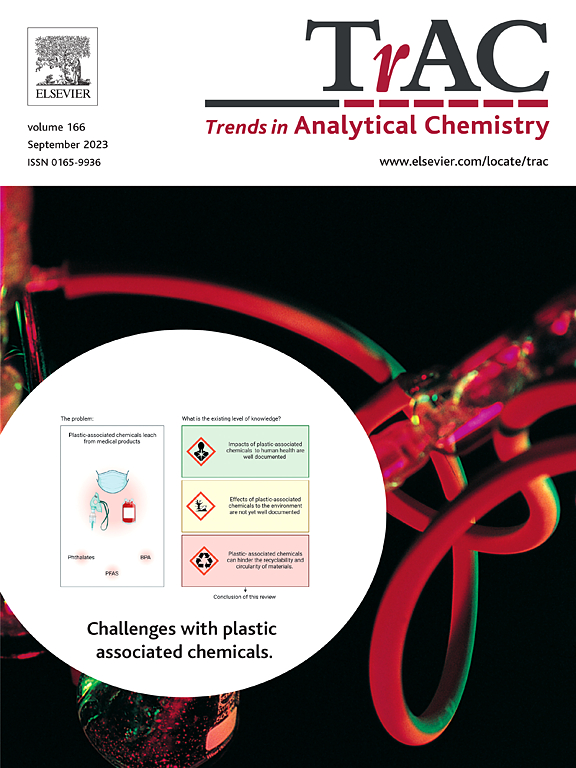Diagnostic potential of breath analysis – Focus on the dynamics of volatile organic compounds
IF 11.8
1区 化学
Q1 CHEMISTRY, ANALYTICAL
引用次数: 0
Abstract
Analysis of exhaled volatile organic compounds (VOCs) holds promise for the development of new and non-invasive procedures in many areas of clinical and home care applications. Recent research mainly focused onto cross-sectional pilot studies with single point measurements in order to detect specific VOC markers or marker sets for diseases such as cancer, infections or diabetes. Actual studies have shown the highly dynamic behavior of exhaled VOC profiles related to factors such as exposure, nutrition, exercise, medication but also to physiology and clinical interventions. Single point analyses cannot take into account neither the fundamentally dynamic nature of exhaled substance profiles nor can they sufficiently reflect the kinetics of exogenous contaminants and confounders and are, therefore, prone to erroneous interpretation, especially if single point analyses are applied for primary diagnostic purposes. These disadvantages cannot be overcome by means of any statistics as complex and sophisticated these algorithms may be.
While unique VOC markers for certain diseases could not be confirmed in independent studies, analytical techniques and tools to identify and monitor VOCs as well as the knowledge on exhaled VOCs have developed significantly during the last two decades of breath research.
As dynamic VOC profiling provides valuable information on kinetics of markers and confounders, it offers huge and so far unexplored potential for physiological, metabolic, therapeutic and environmental monitoring. Driven by new and innovative technologies such as real time mass spectrometry and highly specific sensor systems, future applications may range from home care to ICU monitoring.
呼气分析的诊断潜力--关注挥发性有机化合物的动态变化
呼出的挥发性有机化合物(VOC)分析有望在临床和家庭护理应用的许多领域开发出新的无创程序。最近的研究主要集中在单点测量的横断面试验研究上,目的是检测特定的挥发性有机化合物标记或癌症、感染或糖尿病等疾病的标记集。实际研究表明,呼出的挥发性有机化合物与暴露、营养、运动、药物等因素以及生理和临床干预有关,具有高度动态性。单点分析既不能考虑呼出物质曲线的基本动态特性,也不能充分反映外源污染物和混杂物的动力学特性,因此容易产生错误的解释,尤其是在将单点分析用于初级诊断的情况下。虽然某些疾病的独特挥发性有机化合物标记无法在独立研究中得到证实,但在过去二十年的呼气研究中,用于识别和监测挥发性有机化合物的分析技术和工具以及呼出挥发性有机化合物的知识都有了长足的发展。在实时质谱法和高特异性传感器系统等创新技术的推动下,未来的应用范围可能从家庭护理到重症监护室监测不等。
本文章由计算机程序翻译,如有差异,请以英文原文为准。
求助全文
约1分钟内获得全文
求助全文
来源期刊

Trends in Analytical Chemistry
化学-分析化学
CiteScore
20.00
自引率
4.60%
发文量
257
审稿时长
3.4 months
期刊介绍:
TrAC publishes succinct and critical overviews of recent advancements in analytical chemistry, designed to assist analytical chemists and other users of analytical techniques. These reviews offer excellent, up-to-date, and timely coverage of various topics within analytical chemistry. Encompassing areas such as analytical instrumentation, biomedical analysis, biomolecular analysis, biosensors, chemical analysis, chemometrics, clinical chemistry, drug discovery, environmental analysis and monitoring, food analysis, forensic science, laboratory automation, materials science, metabolomics, pesticide-residue analysis, pharmaceutical analysis, proteomics, surface science, and water analysis and monitoring, these critical reviews provide comprehensive insights for practitioners in the field.
 求助内容:
求助内容: 应助结果提醒方式:
应助结果提醒方式:


